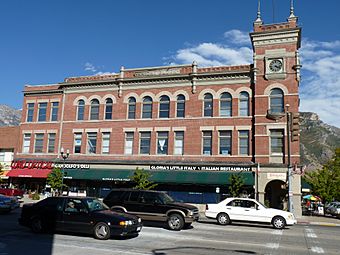Knight Block facts for kids
Quick facts for kids |
|
|
Knight Block
|
|

Looking east at Knight Block, September 2011
|
|
| Location | 1-13 East Center Street and 20-24 North University Avenue Provo, Utah |
|---|---|
| Area | less than one acre |
| Built | 1900 |
| Architect | Richard C. Watkins |
| NRHP reference No. | 77001322 |
| Added to NRHP | December 2, 1977 |
The Knight Block is a special old building in downtown Provo, Utah. It's located on South University Avenue, which is also U.S. Route 189. This historic building is important enough to be listed on the National Register of Historic Places. It was once the main office for a very successful businessman named Jesse Knight.
Contents
The Knight Block Building
The Knight Block was built in the year 1900. It served as the main business office for Jesse Knight. This building was recognized as a historic place in May 1977. It was added to the National Register of Historic Places.
Building Design and Features
The Knight Block is a three-story building. It has a rectangular shape. The ground floor was used for shops and stores. There is also a basement. The two upper floors were used as offices.
The building is made of red bricks. It has gray limestone blocks around the windows. These are called lintels. On the southwest side of the building, there is a clock tower. This tower rises above the roof. Over the years, some parts have been added to the building. For example, three sections were built on the north side of the western wall. The inside of the main floor has also been changed.
Meet Jesse Knight: A Utah Pioneer
Jesse Knight was born in 1845 in Nauvoo, Illinois. He was one of the richest people in Provo during his time. Jesse's family moved west and arrived in Utah in 1857.
Twelve years later, Jesse married Amanda McEwan. They started a ranch in Payson, Utah. Jesse had a strong feeling that he should start mining. He began a mining business in the Eureka area. This business made him very wealthy.
Jesse Knight's Business Empire
After his first success, Jesse bought more mines. He also started a bank. He purchased many properties in Provo. He even bought the Provo Woolen Mills. Jesse also started farming and raising cattle in Canada.
Even with all his business ventures, Jesse was a strong supporter of The Church of Jesus Christ of Latter-day Saints. His mines were known as the "cleanest mining camps in the west." Jesse Knight passed away in 1921. He left much of his money to BYU and other important organizations.
Jesse Knight and Utah's Mining History
Mining for valuable metals and minerals changed Utah's economy. It helped Utah grow from mostly farming to a more industrial state. The Tintic Mining District was a very important mining area. It was founded in 1869. By 1899, it was the top mining center in Utah. It produced five million dollars worth of minerals.
Jesse Knight and his family, who lived in Provo, were key figures in Tintic's success. Jesse Knight became rich with his Humbug mine in the mid-1890s.
Jesse Knight's business grew beyond the Tintic mines. He invested in a power plant in Santaquin. He also supported the Tintic drain tunnel project. His businesses included the Knight Dry Farm and smelters in Silver City. The Bonneville Mining Company and the Knight Woolen Mills were also part of his investments. Other companies included the Ellison Ranching Company and the American-Columbian Corporation. He also owned the Springville-Mapleton Sugar Company and the Spring Canyon Coal Company. Jesse Knight also founded the Utah Savings Bank and the Layton Sugar Company. All these businesses were part of the Knight Investment Company.
The money Jesse Knight earned helped build many important structures. These include not only the Knight Block, but also the Knight–Mangum House, the Knight–Allen House, and the Jesse Knight House.



